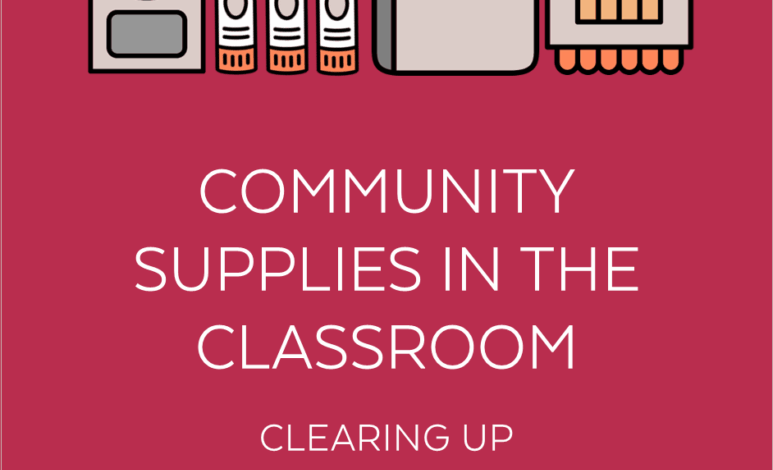Community Supplies in the Classroom: Clearing Up the Confusion


Listen to the interview with Julie Lause:
Sponsored by Alpaca and EVERFI
If you’re a parent or a teacher, you’ve probably seen the annual school supply debate online. Flipping through your phone on any social media platform, you’re bound to see:
- The tearful story of a 7 year old who had his Spiderman folder, pencils, and erasers summarily collected by the teacher on the first day of school and thrown in the communal bin.
- A mom with a sharpie aggressively writing her child’s name on EVERY INDIVIDUAL CRAYON.
- A teacher in line at Walmart using her paycheck to purchase pencils for her class because 15 out of 30 parents opted out of sending school supplies.
And if you read the comments? Heartbreaking.
“I don’t want my hard earned money going to kids whose parents don’t even care about them enough to send supplies. So I’m not sending supplies.”
“Lazy teachers hoard those supplies and sell them to make money.”
“Why can’t supplies just be handled the way they were when I was a kid?”
As someone in the middle of many such battles, I see both sides: parents feeling taken advantage of because they suspect they’re contributing more than their fellow parents, and teachers who have to purchase supplies from their own paycheck so all the kids in their class can learn.
Most parents want to be generous to their community. And most teachers and schools create a fair system for school supplies. The problem comes when the expectations of the parent (and thus the child) are different from the systems the school has set up.
This article aims to help mend the rift.
What are Community Supplies?
Most K-8 schools use some kind of teacher-managed system for supplies. Depending on where you live, they go by different names: community supplies, communal supplies, or my personal preference — teacher-distributed supplies. If your school uses a system like this, it means the classrooms your child goes to each day will have a stock of supplies that kids do not manage themselves.
This can look a variety of ways depending on the systems of the school:
In a Kindergarten class, each student’s chair has an attached supply bag replenished by the teacher every week:
A teacher has two cups of pencils at the front of the room: one for students to deposit dull pencils and the other for sharpened pencils that they exchange as needed:
Some classrooms stock colored pencils and other supplies for everyone to access:
During class, students who need a new pencil or a sharpened one put their finger up and while teaching the lesson, the teacher trades their dull pencil for a sharpened one:
The Problem
The problem isn’t the way the school manages supplies; it’s the mismatch between how parents expect supplies to work and how the teacher actually manages them.
If you take your child to pick out personalized supplies but the school collects supplies on the first day, your child is going to be disappointed to see their Spiderman folder put into the collective pile. That’s why it’s SO important to know how your school handles supplies so you can match your parent moves with the school system.
It’s this mismatch that causes resentment from parents, and rightly so. They set their kid up for one kind of experience, and they get another (more unpleasant) one.
On top of that resentment, when parents hear “communal supplies” they may erroneously believe they are contributing while others are not. That unfairness is why parents say things like “The teacher stole my child’s supplies and gave them to needy kids.” Or why they only send two pencils and not 24 — because they believe their child will use two pencils all year and the rest are going to other kids.
Let’s be clear: Some of the supplies a parent sends in for their child might go to someone else, but it’s most likely because of the way elementary school supplies are handled.
For instance, students will use five glue sticks a year, but those five glue sticks aren’t stored in a bag labeled with your child’s name. That is a practice from daycare when diapers and food are very personal. In elementary school classrooms, one pencil or glue stick is the same as the next. To distribute every child’s individual glue stick that has their name on it to the proper child would take 15 minutes. Instead, the teacher puts the glue sticks in a bin at the beginning of the year. When the class needs glue sticks, she walks the bin around the room in 30 seconds and every child has what they need.
If you send 48 pencils and put your child’s name on them, some other child will get that pencil. It’s not because they’re “needy” or didn’t bring their supplies. It’s because teachers manage supplies as a system for the whole room.
Why the Mismatch?
We all have our memories of school supplies growing up. If we kept personal supplies in our desk 20 years ago, we might think that’s how our kids’ school works. But our memories may be misleading: We may have forgotten that the classroom we went to each day was fully stocked with essentials. Those Hello Kitty erasers were not “mission critical.” They were fun and precious to us, but the teacher stocked glue sticks and construction paper. Our parents likely weren’t being asked to send in those necessary supplies for the whole year like schools ask parents to do now.
That’s because school funding has really changed. It is much more costly to operate public schools now than it was in the 70s and 80s, and districts are asking parents to offset some of that cost by contributing supplies.
Matching Your Parenting Moves to the School’s Systems
Every school is different. The important thing is to match your parenting moves with the teachers’ systems. If the school hasn’t let you know how they handle supplies by a month before school starts, contact the school to find out. Then you can act accordingly.
Two things to find out:
- Who purchases supplies? Schools may give a list to purchase or have parents send the school a certain amount of money so the school can make a bulk order. If it sounds like a lot, keep in mind it’s designed to supply students for the whole school year.
- Who manages supplies? If the teacher manages them, they will usually collect physical supplies in the first days of school. If the student is expected to manage them, your family should come up with a system to help your student keep track of their supplies.
When supplies run out, schools might ask parents to send in more or they might have a budget to supplement what parents send in.
Teachers work hard to ensure that children don’t feel left out or different, and that includes ensuring everyone has the same access to learning and materials. Schools aren’t perfect, but they are communities. If you want to make sure that teachers never have to use their paycheck to do their job, consider sending in even more supplies/money than is expected. That helps cover the cost of any students who aren’t able to contribute and is a beautiful way to support a community you care about.
Frequently Asked Questions and Concerns
Here are a few questions I’ve encountered along the way.
“Teachers are so controlling. Letting kids get up to sharpen their pencil or rifle through their backpack is no big deal.”
When the teacher has to wait on 25 students to find their own supplies every hour, this is wasted time for your child. And since every child sharpens their pencil an average of 3 times a day, pencil sharpening is a system in each classroom too! This might feel controlling if you think of your child as an individual, but if you think of them as part of a collective, you don’t want them in a classroom where all 25 kids are up and moving around every hour. It’s just not conducive to learning.
“If kids don’t manage their own supplies, they’ll never learn responsibility.”
Yes, a teacher COULD teach every student to manage their own supplies, but the sheer scale of that project would go well beyond the time a teacher has available. Imagine your child coming home with stories of lessons on supply management, and how much time they had to sit bored while the teacher replenished their peer’s supplies. You would probably rather they were learning math or practicing their writing. To maximize academic learning and to make sure kids aren’t sitting and waiting for supply issues, the teacher creates systems as a collective class.
In high school, it’s appropriate for students to keep their supplies in their own bag. They have far fewer supplies than younger students, who can’t be expected to have all crayon colors of the rainbow, a glue stick, a ruler, construction paper, and a pencil available at a moment’s notice.
“Why can’t they keep their supplies in their desk like we did?”
Some schools have this system, but the vast majority of American schools use departmentalized learning, meaning that even young children learn English from one teacher and math from a different teacher; they might rotate classrooms and use four different desks a day. This has positive academic outcomes because of the expertise of the teacher and the rigor of the instruction, but it means managing supplies is a school-based system because teachers share students more than they used to. They either need a system where they travel with supplies or the teacher has supplies in each classroom they visit.
“Teachers are just keeping these supplies for themselves.”
If you notice that teachers have a perhaps unhealthy passion for school supplies, it’s because many of them will be responsible for paying their own money to supply the children in their class if supplies run out. Teachers storing all the supplies in a closet and keeping close tabs on them is a natural response to the situation they’re in. And believe me, there’s no black market for glue sticks.
“I want to purchase special supplies just for my child like I remember.”
You can! Back-to-school shopping can be a fun way to get kids invested in their education. Your best bet is to ask the teacher if they can have their own personal supplies in addition to the class supplies, and if the classroom is set up so they can have access to those, go ahead and purchase! You might want to wait a day or two to send those supplies with your child on the off-hand chance they get collected with the bulk supplies on day one.
The important thing to remember here is that even if your child has their favorite unicorn pencil and erasers in their bag, they will still use 48 pencils, 3 glue sticks, and 50 crayons during the year. They will still need access to the classroom stock of supplies, so you should still plan to contribute to those.
Another reason teachers might not approve personal items is that when these things get lost or stolen, teachers are the ones who have to spend precious instructional time hunting down a unicorn pencil. As a teacher and principal, my guideline for families was they could send an item to school as long as they didn’t mind if it gets lost or stolen.
If your child won’t have access to personal items during the day or the teacher wants to avoid special items, you can always set up a homework station at home with fun supplies. A caddy of exciting supplies your child picked out is JUST the way to make homework more fun. And between school itself and homework time, homework is the one that needs the incentive.
“I’m not sending supplies for other people’s children.”
While supplies you send might be used by other children because the teacher is using the collected supplies for the group, your child will use 48 pencils, 3 glue sticks, a pack of crayons, and a pack of construction paper inside of one year. The list your teacher sends is the list of what a typical child consumes in a year, so even if another child gets access to supplies that you sent in, isn’t sending in the full set of what your child will use the right thing to do?
“Why can’t my child have a character folder that they like?”
The answer is always going to be systems. Schools use folders for a variety of reasons, but here are a few reasons why the school might collect and re-distribute all the folders, and why therefore your child can’t have a personalized Spiderman folder:
- The school uses a very specific homework folder that is the same for every child. The specific folder might be selected for durability or continuity.
- Folders might be color-coded for a particular classroom or grade so when one is found on the playground the school can easily narrow down who it belongs to. When you supervise 500-1000 students, you develop ways to save time reuniting lost stuff with its owner.
- A teacher might use folders inside the classroom for specific purposes, and those purposes are color-coded. The child’s writing folders are all yellow, for example, so the teacher can say “Take out your yellow folder for writing.”
- The folders might be used later in the year. If the teacher is going to collect them in August but use them in November, reuniting every child with their special folder would take too long (and lead to arguments). It’s simpler just to redistribute those generic folders in 1 minute.
“Just tell me when my child’s supplies are running low.”
Though this might be done in an early childhood or daycare setting because diapers, formula, and food are so personalized at the infant stage, in K-8 classrooms the student-teacher ratio isn’t 6 to 1 like it is at daycare. And classroom supplies don’t need to be personalized to work effectively as long as everyone has the basic supplies.
It’s not feasible for teachers to make a phone call to each individual family when supplies are running low. And it’s not reasonable to expect parents to drop everything and rush to the school to provide a pencil. That’s why teachers need their classrooms stocked with supplies. Checking your child’s bag every day and keeping a supply backstock in your home so you can replenish on a daily basis is a huge pain. If your child is in a classroom with teacher distributed supplies, my suggestion is to embrace this huge benefit to you.
“My child shouldn’t have to use cheap supplies if I buy the expensive ones.”
Poor Rose Art Crayons, the enemy of parents everywhere. The reality is kids don’t care that much, and teachers are focused more on kids being able to do the activity, not the quality of the supply.
My suggestion is to embrace the community aspect of school, and understand that though your child will not always have the very top-of-the-line materials, they will get what they need and so will their peers. You can provide whatever quality of materials you want in your home, and your child will get to be a part of a community that provides for everyone.
You can find Julie’s playlist on school supplies on her TikTok account.
Join our mailing list and get weekly tips, tools, and inspiration that will make your teaching more effective and fun. You’ll get access to our members-only library of free downloads, including 20 Ways to Cut Your Grading Time in Half, the e-booklet that has helped thousands of teachers save time on grading. Over 50,000 teachers have already joined—come on in.





